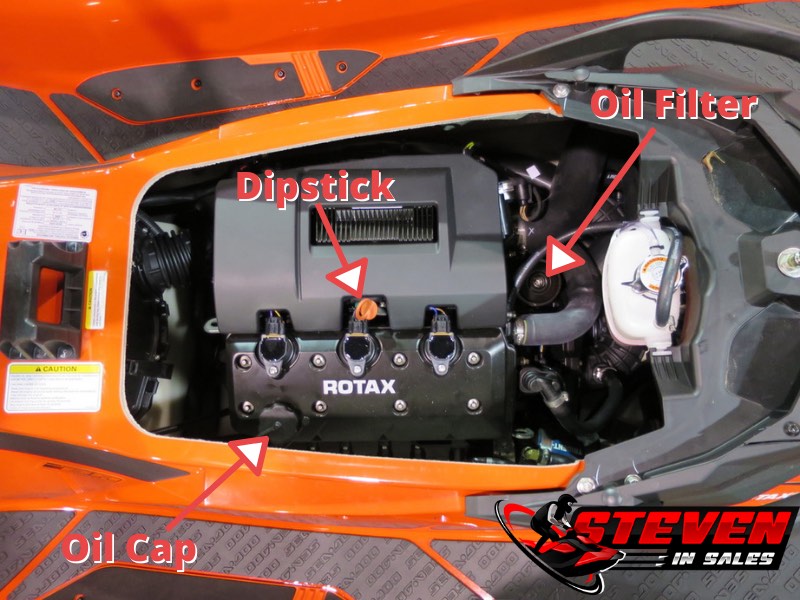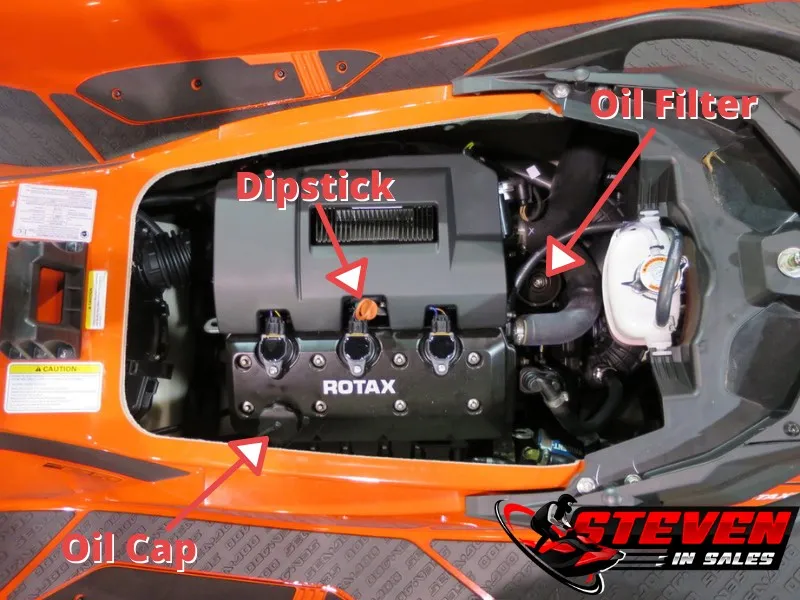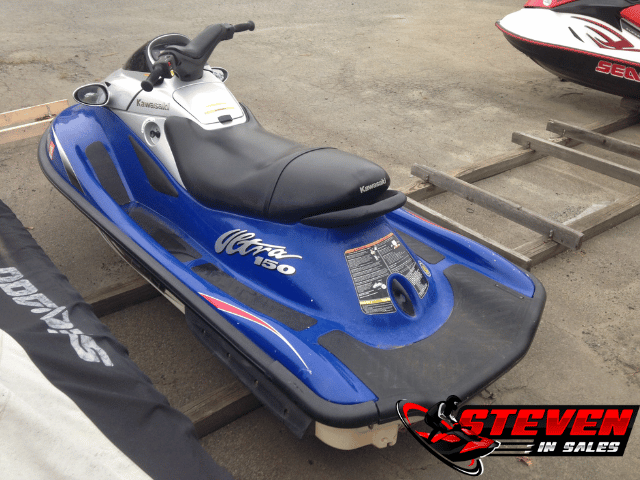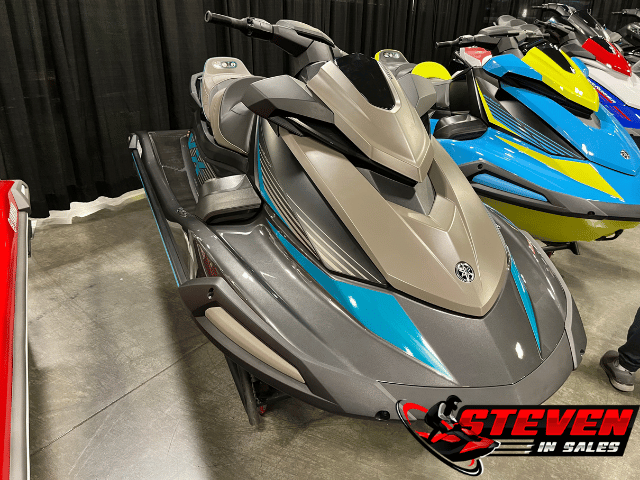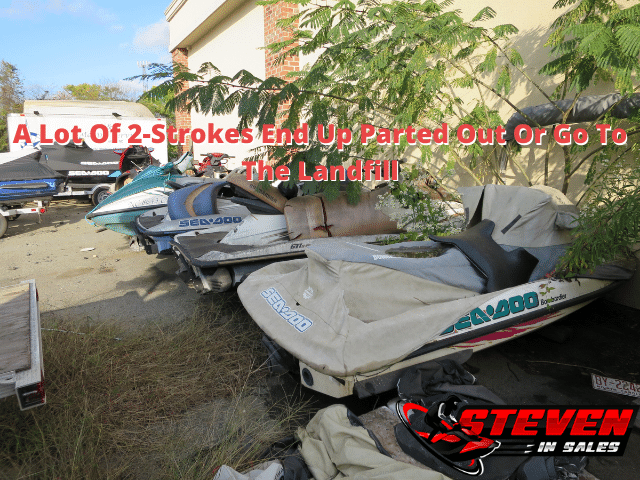When you look into jet skis, you may come across the words 2-stroke and 4-stroke and wonder what they mean?
Is a 4-stroke (4-cycle) better than a 2-stroke (2-cycle), what is even the difference between them, and should you care?
In this post, I want to answer these questions and more, while also helping you figure out if you should get a 2-stroke or 4-stroke.
The Difference
2-stroke
A 2-stroke refers to the type of engine.
The 2-stroke name comes from how many strokes (down, then up) of the piston are needed to perform before combustion.
2-strokes are unique because they simplify things.
They mix gas and oil to reduce parts and save time.
The piston gets lubricated when air and gas/oil mix in, and when it goes up, it fires again.
However, some gas/oil mix can escape through the exhaust, which is why 2-strokes are less popular now (it pollutes the water).
In 2-strokes, you don’t change the oil; you just add oil occasionally. They often have their own oil tanks and only need oil added every few tank fill-ups.
4-Stroke
What makes a 4-stroke engine different from a 2-stroke engine is how the oil is handled.
In a 2-stroke, the oil is mixed with the gasoline, but in a 4-stroke, the oil is not mixed.
Here is how a 4-stroke engine works.
Since 4-stroke engines don’t mix the oil, they instead recycle it and the oil must be changed every year or every 50 hours, whichever comes first.
4-strokes have become the most common engine type used by watercraft and most vehicles like your car today.
How To Know If You Have A 2-Stroke or A 4-Stroke PWC?
The easiest way to determine if you have a 2-stroke or a 4-stroke is by looking for a “dipstick”.
Only a 4-strokes will have a dipstick located on the top or near the top of the engine, as shown in the picture below.
Another way to determine is by the age of your PWC. The last two digits of your VIN tell you the year. The VIN is located at the rear on the right of your PWC, either on top or below the rub rail.
The First 4-Strokes
Yamaha introduced their first 4-cycle WaveRunner in May 2002. Any Yamaha built in 2001 or earlier is a 2-cycle. The last sit-down Yamaha with a 2-cycle engine was the 2012 WaveRunner VX700S, and standup models had 2-cycle engines until 2020 when the 2021 SuperJet adopted a 4-cycle engine. Consequently, sit-down Yamaha’s made in 2013 or later are 4-cycle, and standup models joined in 2021.
Sea-Doo’s first 4-cycle came in 2002, and the last 2-cycle was in 2007. So, any Sea-Doo from 2008 onwards is a 4-cycle, while those made before 2002 are 2-cycle. It’s worth noting that every Sea-Doo with a 4-cycle engine also has closed-loop cooling, which remains true today.
Kawasaki introduced their first 4-cycle in 2003 and stopped making 2-cycle models in 2016. They released a new 4-cycle standup model in 2017.
What’s Better?
Both 2-stroke and 4-stroke each have their advantages, but overall, 4-cycle is better and what you see in most today.
2-stroke are being phased out because they pollute more and don’t last as long as the 4-stroke.
It’s not all bad things with 2-stroke, here are the pros and cons of both 2-stroke and 4-cycle.
2-Stroke Pros:
- Lighter and more torque.
- Simpler designs.
- “Easier” to work on.
- 2-cycle engines were common in early watercraft until the early 2000s when 4-cycles emerged.
- Smaller engines made waverunners more playful. Look at the “Sea-Doo HX” for a great example.
2-Stroke Cons:
- They pollute more because they burn the oil.
- Many places have banned 2-strokes because of how much they pollute.
- They are louder and lack sound dampening, contributing to noise pollution and leading to bans on many lakes.
- 2-strokes are being phased out, making new parts hard to get from the manufacturer. Aftermarket parts are less available compared to cars, so you’ll mostly get used parts online, like eBay.
- Messier engine, makes more of a mess in the engine compartment due to it burning oil!
- 2-strokes foul spark plugs more due to burning oil. Many 2-strokes include a spark plug changing kit under the seat because of this issue.
- Not as reliable, it was not uncommon to do a whole engine rebuild on a 2-stroke before 300 hours.
- 2-strokes consume more gas, since most used carburetors. Some had basic fuel injection, but it wasn’t as good as today’s 4-strokes. I suggest avoiding Sea-Doo’s with “DI” or “RFI” in the name; they have issues.
4-Stroke Pros:
- More reliable than 2-strokes, we’re seeing 4-strokes go over 500 hours easily, with some even hitting 1,000 hours.
- Easier to get parts for 4-strokes compared to 2-strokes.
- Doesn’t pollute nearly as much.
- Better on gas, with many models today having driving modes like ECO.
- Reach higher speeds than 2-stroke. Given enough time 2-stroke could have gotten to these higher speeds but since they’re phased out you want to get a 4-stroke if you aim to go fast.
- 4-strokes are more stable than 2-strokes because the engine are bigger, so they needed to be bigger.
4-Stroke Cons:
- 4-strokes are larger and less nimble than 2-strokes, but the Sea-Doo Spark and Yamaha EX are exceptions; they’re nimble 4-strokes.
- 4-strokes are more complex and have more computers.
Avoid 2-cycles If You Ask Me
Since starting this website in 2014, I’ve consistently advised against 2-cycles, which is also the main point in my used post.
2-cycles have become even rarer, and finding parts is getting tougher.
Unless you enjoy working on jet skis and can source used 2-cycle parts, it’s not worth it for most. 4-cycles are what most people prefer for reliability, fuel efficiency, comfort, technology, and family-friendliness.
What Killed 2-Strokes?
2-stroke are not a thing you see anymore, and the main reason is due to the EPA.
The EPA started cracking down on pollution, and 2-stroke were the most polluting.
The 2-stroke engines either needed to be changed or phased out, leading to their replacement with 4-stroke engines. 4-stroke engines do not burn oil; instead, they utilize direct injection to reduce gas wastage, and many of them offer various driving modes to mitigate pollution.
The manufacturers see the writing on the walls, so the next jump will be to electric. Sea-Doo has shown us their electric jet ski plan, and I’m certain Yamaha and Kawasaki are testing some themselves. We go a bit into electric jet skis in this post here.
